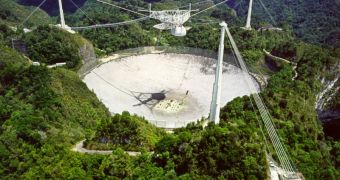Well... not you specifically, just your computer! After some extensive upgrades of the Arecibo radio telescope which included, aside the first paint job in more than four decades, the installation of seven new radio receivers that allow the telescope to extend its radio spectrum to over 40 times that of the original, SETI suddenly realized that they did not have enough computers to process the huge amount of data they are currently receiving.
The Arecibo land-based radio telescope located in Puerto Rico and operated by NASA is the biggest of its kind, having a radio dish of about 300 meters in diameter. The dish is routinely used by the Search for Extraterrestrial Intelligence program to scan the heavens for eventual intelligent radio transmission sent by another civilization. So far, the three decade program was only capable of picking up background signals emitted by the universe, a few microwave ovens and a signal thought to be of extraterrestrial origin which cannot be confirmed because it did not reappear after its detection in 1977, the famous 'WoW' signal.
The equipment provided during its latest update allows SETI to scan Radio Frequency signals in order to detect polarization and to stream about 500 times more information from the radio dish. This means that SETI is currently capable of scanning billions of channels in the RF band, which poses some kind of a problem since they do not have enough computing power to process such enormous amount of information.
SETI has been greatly disregarded in the last years due to its inability to find any 'aliens' and accused in numerous occasions for pseudoscience. Nevertheless, it quickly became dependent on millions of volunteers supporting their work by providing with access to their home personal computers, which eventually became the world's biggest supercomputer cluster. However, the total of 300,000 computers which could be online at all time are not enough considering the amount of data increase of over 500 times.
Thus SETI makes an appeal to all the passionate and supporting volunteers to sign up at SETI@Home in order to offer their computer services to them. Developed by David Anderson from the Berkeley Open Infrastructure for Network Computing, SETI currently operates more than 42 separate projects on the BOINC network that processes the signals in order to detect intelligent life. So far, volunteers have been more than enough, but with an information volume of about 300 gigabytes per day, SETI needs more now.

 14 DAY TRIAL //
14 DAY TRIAL //